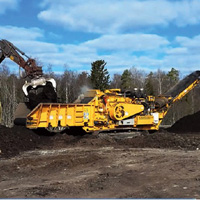Crushed bark as a novel soil conditioner for organic plant production

Accepted: 21 May 2021
PDF: 456
All claims expressed in this article are solely those of the authors and do not necessarily represent those of their affiliated organizations, or those of the publisher, the editors and the reviewers. Any product that may be evaluated in this article or claim that may be made by its manufacturer is not guaranteed or endorsed by the publisher.
Due to the reduction of cattle farming, the Finnish agricultural sector currently needs solutions to replace animal manure with new sustainable alternatives. This problem is especially acute for organic farms, which need livestock manure to improve soil fertility and soil organic carbon (SOC) to sustain yield. On the other side, plywood manufacturers aim to find ways to reuse waste fractions such as sandy, wet spruce bark waste. To address both issues, a new soil conditioner was developed from crushed bark (CB) and approved for organic farming by the Finnish Food Authority. To test the advantages of CB in organic wheat production, we conducted a two-year field experiment on a farmer’s field in Mikkeli (Finland) on loamy sand with moderate soil fertility (C 3.5%, C/N ratio 17, pH 6.2). CB (organic matter 80%, C/N ratio 78, pH 5.7-6.0) at 40 t ha–1 was applied either in the first year of the experiment or in both years. In addition to CB, half the plots received base ash (4 t ha–1) obtained from a power plant using wood to maintain the optimal soil pH. All plots were fertilised annually with commercial organic fertilisers. The control plots received no CB or base ash. A one-year application of CB with base ash statistically significantly increased the grain yield by 800 kg ha–1 and grain N uptake by about 10 kg ha–1 in the following growing season compared with the control. In terms of grain yield quality, a one-year application of CB with or without base ash already showed an improvement of 1000 seed weight by 2 g in the first year, and the effect was even more pronounced in the second year of the experiment. Hectolitre weight was increased in the following year after application of CB with base ash. In contrast, a two-year application of CB either alone or with base ash caused no changes in grain yield, N uptake, or yield quality compared with the control. The results indicate that the use of spruce CB with a high C/N ratio as soil conditioner in a large amount may be beneficial in terms of yield and quality when it is applied only once, but not twice in successive years. Future studies need to focus on the long-term residual effects of CB on productivity, as well as soil parameters such as SOC, cation exchange capacity, and soil microbial activity.
Highlights
- Crushed bark (C/N ratio 78) - a side stream of plywood manufacture - was tested in a two-year organic field experiment.
- A one-year (40 t ha–1) application of crushed bark with base ash increased yield and the quality of organic wheat.
- Residual effects of a one-year application were pronounced.
- Crushed bark application in two successive years provided no benefits for organic wheat production.
How to Cite

This work is licensed under a Creative Commons Attribution-NonCommercial 4.0 International License.
PAGEPress has chosen to apply the Creative Commons Attribution NonCommercial 4.0 International License (CC BY-NC 4.0) to all manuscripts to be published.

 https://doi.org/10.4081/ija.2021.1781
https://doi.org/10.4081/ija.2021.1781



